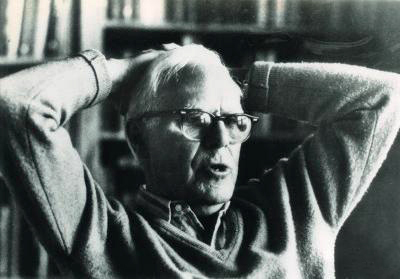Today is the 10th anniversary of the death of Martin Gardner. His books on mathematics had a huge influence on me as a teenager, and I’m a fan of his writing on magic as well, but it was only last year that I branched out into reading some of his essays on philosophy, economics, religion, literature, etc. In this vein, I highly recommend “The Night Is Large”, a book of collected essays which showcases the astonishingly broad range of topics about which Martin had something interesting to say. It’s out of print, but it’s easy to find an inexpensive used copy if you search online.

Thinking back on my favorite Martin Gardner columns, my all-time favorite has to be the April 1975 issue of Scientific American. In that issue, Martin wrote an article about the six most sensational discoveries of 1974. The whole article was an April Fools’ Day prank: among the discoveries he reported were a counterexample to the four-color problem and an artificial-intelligence computer chess program that determined, with a high degree of probability, that P-KR4 is always a winning move for white. The article also contained the following:
In number theory the most exciting discovery of the past year is that when the transcendental numberis raised to the power of
times
, the result is an integer. The Indian mathematician Srinivasa Ramanujan had conjectured that
is integral in a note in the Quarterly Journal of Pure and Applied Mathematics. Working by hand, he found the value to be 262537412640768743.999999999999… The calculations were tedious, and he was unable to verify the next decimal digits…
In May 1974 John Brillo of the University of Arizona found an ingenious way of applying Euler’s constant to the calculations and managed to prove that the number exactly equals 262537412640768744. How the prime number 163 manages to convert the expression to an integer is not yet fully understood.
The reference to the paper of Ramanujan is actually legitimate; he discovered a number of such “near integers”, this one being the most remarkable looking, but Ramanujan was fully aware that none of these were actually integers. In fact, can be shown to be transcendental using the celebrated Gel’fond-Schneider Theorem.
The Gel’fond-Schneider theorem, proved in 1934, says that if and
are algebraic, with
and
irrational, then any value of
is transcendental. (Note that
is defined by setting
. Although
is well-defined only up to a multiple of
, the Gel’fond-Schneider theorem applies to any such choice.) In our situation, let
and
. Of course,
is algebraic but not rational, and
by Euler’s identity. It follows from Gel’fond-Schneider that
is transcendental.
In order to understand why is within
of being an integer, one needs to know a bit about elliptic curves, the modular
-function, complex multiplication, and ideal class groups. That’s a bit much to cover in a short blog post like this… Luckily, though, I gave my first-ever math talk, as a graduate student in 1995, on this very topic, and I’m attaching here a PDF of the notes I wrote up for that talk. (My writing style has improved significantly, I think, in the last 25 years, so please forgive the terse exposition.)
Anyway, I learned a hell of a lot of math trying to understand this particular April Fool’s joke, so I’d like to thank Martin Gardner for the inspiration (in this and many other matters).
Concluding remarks
(1) See also this Stack Exchange discussion or this Math Overflow post for additional discussion of why is almost an integer (and various generalizations of this fact).
(2) For a proof of the Gel’fond-Schneider theorem, see for example http://people.math.sc.edu/filaseta/gradcourses/Math785/Math785Notes8.pdf
(3) As Keith Conrad points out, “John Brillo” is a play on the name of the distinguished computational number theorist John Brillhart.
I remember that talk!
Also, the appeal to Gelfand-Schneider is a little cryptic given the expression as is — you may want to give a hint about rewriting 163 as -1 × -163 and using Euler’s identity.
Rafi, that’s amazing that you remember that talk. You’re totally right about my initial appeal to Gelfand-Schneider — I’ve added some details which I hope now make this less cryptic for readers of this blog!
That was a fun talk — one that I aspire to emulate any time I give a talk or presentation about math.
Pingback: Math Prankster Martin – The nth Root
Thank you for sharing! I love Martin Gardner, too! Wish Ramanujan had lived longer.
It’s just so beautiful. absolutely commendable commendable and many more